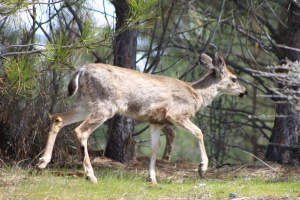 California Department of Fish and Wildlife (CDFW) researchers have captured and collected hair and blood samples from more than 600 deer and elk in an effort to understand “deer hair-loss syndrome,” says a CDFW news release.
California Department of Fish and Wildlife (CDFW) researchers have captured and collected hair and blood samples from more than 600 deer and elk in an effort to understand “deer hair-loss syndrome,” says a CDFW news release.
A non-native louse appears to be a key factor in the syndrome, which also sometimes includes internal parasites. Deer with the syndrome are skinny, and the fawns don’t survive. A report from Fox 40 in Sacramento notes that the syndrome has been known in Oregon for years.
“Some of us speculate that the louse-infested deer spend so much time grooming they become easy targets of predation by coyotes or mountain lions,” said CDFW senior wildlife biologist, Greg Gerstenberg in the release.
The researchers have counted and identified lice on the captured deer, are following them through radio collars, and have treated some for lice. They hope to have answers soon.
Read the brief CDFW news release, here.
The Fox 40 report is here.
Mule deer are in decline throughout the West, and California is no exception. This article from 2010 in the San Francisco Chronicle discusses the decline.
Photo: Deer with hair-loss syndrome, courtesy of the California Department of Fish and Wildlife
